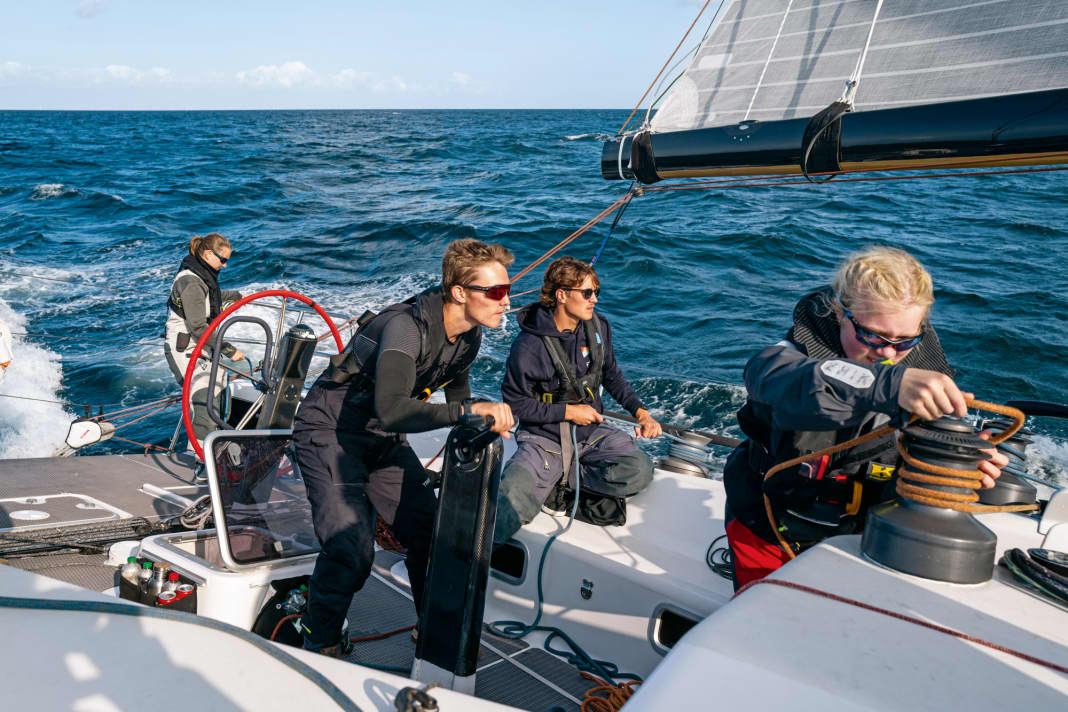





"Trim!" thunders through the cockpit. The boat is just about to start fiddling. One of the young crew members frantically starts cranking the grinder. The winch creaks violently under the weight of the gennaker sheet, which is now being tightened again after having just been hoisted by another team member. He stands in front of the cockpit, looks into the sail and now starts to furl again. And so the process is repeated incessantly. Sometimes it takes longer, sometimes it goes faster, until it thunders again: "Trim!"
The scene is set on board the "Haspa Hamburg", which is sailing in the Commodore Cup today. This junior regatta from Kiel to Travemünde is taking place for the tenth time and its unique concept is to give juniors the chance to demonstrate their skills.
A junior skipper makes, a professional coach advises
Held for the first time in 2014 under the name Offshore Youngsters NachwuchsregattaKiel-Travemünde, the event is organised jointly by four sailing clubs that feel connected to sailing. The Hamburgischer Verein Seefahrt (HVS) is the patron organisation, while the team led by race director Alexander Beilken from the sailing club Das Wappen von Bremen (SKWB) is responsible for the regatta part of the event. The Kieler Yacht-Club (KYC) is responsible for the start organisation, while the Lübecker Yacht-Club (LYC) is in charge of the finish organisation.
The idea behind the regatta is as simple as it is ingenious: there is one junior skipper and one coach per boat. The junior skipper does not even have to fulfil the criteria required to skipper the boat, but makes all the relevant decisions and takes care of the entire organisation. The coach is authorised to steer the respective boat and is always on hand to offer advice, but does not intervene in the management of the boat during the race. What began with eight boats on the starting line will see more than 200 crew members on 22 yachts on the water this year.
Make sandwiches and set the route before the start
What has remained is the date at the end of the season. Late summer has already turned into autumn. As the first view from the companionway across the deck on Saturday morning before setting sail for the start, everything is still a little damp from the dew.
Nevertheless, they go out for the safety briefing. The twelve crew members gather on the foredeck and form a semi-circle around 21-year-old Gesine Wutzler. As the junior skipper, she is the boss on board today and everyone listens intently to her - hands buried deep in their pockets, as it is still quite fresh - about what needs to be observed.
Below deck, she then discusses the routing for the race with navigator Mats, who is already poring over the nautical chart. They set off under gennaker towards Fehmarn. "Flat in front of the sheet," says Gesine: "The wind isn't so good for us, we'll have to jibe a lot."
The bread roll greasing station is very important. Below deck, it smells of freshly baked food and a hint of garlic. The finished rolls are placed in a huge cooking pot. It is ready to hand to feed the entire crew throughout the day.
Finally it's time to cast off! From the old Olympic harbour in Kiel's inner fjord, the first stop is Strande, where the kangaroo start takes place, in which each participating yacht is given its own start time based on the time it is expected to need for the race.
The "Haspa Hamburg" is a racing cruiser with reserves
This year, the race organisers have modified the procedure and formed several starting groups. As one of the faster ships, the "Haspa Hamburg" will be in the last group together with the "Broader View Hamburg" and the "Halbtrocken 4.5" and is scheduled to cross the line at 9.45 am.
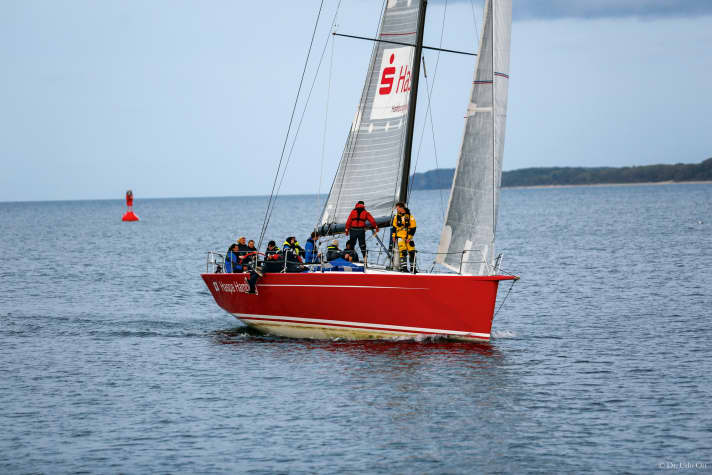
The "Haspa Hamburg" has belonged to the HVS since its launch in 2009 and is a "long distance cruiser/racer" modelled on a TP52, sporty and without any luxury. "But the boat is built a little more stable and safer in some places than the model TP52," says Davina Zahn, coach on board the "Haspa". It should also be possible for small crews to transfer safely and without great risk. The tubular bunks on board can accommodate between ten and twelve people.
The "Haspa Hamburg" was designed by Judel/Vrolijk & Co in Bremerhaven and built by Hakes Marine Limited in New Zealand. The ocean-going yacht is 17.2 metres long, 4.8 metres wide and displaces 12.8 tonnes, of which 4.5 tonnes are ballast in the keel bulb. The mainsail measures 97, the 100 per cent headsail 70 and the gennaker 250 square metres.
The skippers should develop- with room for error
The start is routine and unspectacular. Soon afterwards we are hailed by Fehmarnbelt Traffic: "Are you also part of the regatta? Are you aware of the restricted areas?" After a curt "Yes!" we are wished a safe journey and we switch back to channel 16.
The areas marked only by AIS buoys were set up for the tunnelling work between Puttgarden and Rødby, and one of them lies exactly on the regatta route. Navigating around them requires skill from both navigator and helmsman. And so skipper Gesine, who is at the helm, checks with Mats, the 18-year-old navigator sitting below deck at the navigation laptop, that we are on the right course. "Everything's OK, we'll leave the buoy just off the starboard side and then turn off," comes the reply from the open hatch in the centre of the cockpit. The navigator's seat is right underneath.
"Sailing the world with young crews" - that is the motto of the HVS. Since 1903, the association has been training young sailors on modern ocean-going yachts and is open to anyone who enjoys it. And this is meant literally. According to the HVS, "developing" means that the active members of the association - mostly young adults - are given the opportunity to develop their skills. With room for mistakes.
It is aimed at teenagers and young adults aged between 16 and 25. The club has between 15 and 20 active skippers who meet every eight weeks to exchange ideas. You can become a skipper if you have a recreational sailing licence, the relevant radio certificates and a certificate of competence for distress signals, the so-called pyro licence. The applicant also needs two skippers who can vouch for the applicant's suitability to manage the ships in a responsible position. If the skippers vote unanimously in favour, the person concerned is then allowed to skipper the three club ships "Haspa Hamburg", "Störtebeker" and "Broader View Hamburg".
Regatta fever just before the finish
Many of the other yachts in the field also belong to clubs that pursue a similar purpose to the HVS. However, some private owners also take part in the junior regatta and make their yachts available for a young crew.
Sailing takes place on the club's own yachts, but some owners also make their boats available for the junior regatta"
The weather means well. Towards midday, the sun is still noticeably strong, and here and there people even take off their oilskins. People talk on board - about their studies, past regattas and shared sailing experiences. Jonas, for example, sailed in the Fastnet Race in the summer, on the "Germania VI" of the Krupp Foundation. It was very turbulent. "We had the spark manned at all times." They learnt how useful this was when the life raft with the crew of a sunken competitor came into view. The radio operator was able to help immediately as a relay station. "In the heavy seas, it wasn't possible to carry out the rescue manoeuvre ourselves with a yacht, but we were able to call for help."
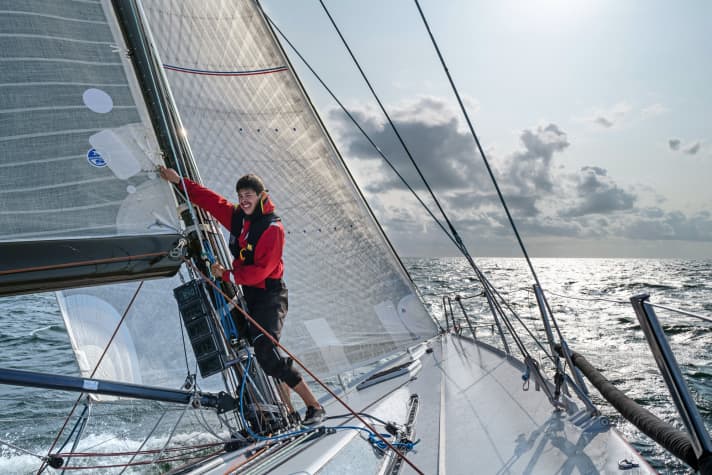
Things get exciting again at the end of the sailing day. Shortly before the finish, the field comes close together again. The crew is gripped by regatta fever and actually manages to overtake many a competitor before the finish.
In the evening, the regatta participants are catered for by a sausage stand and a beer trolley. The young offshore sailors have a lot to talk about until late in the evening when the "Störti Pop", the unofficial anthem of the HVS, is played in the LYC clubhouse, heralding the start of the relaxed part of the evening.
"Semi-dry 4.5" wins the Commodore Cup 2023
The award ceremony takes place on Sunday morning. The Commodore Cup is won by Michael Berghorn's "Halbtrocken 4.5" from the Kiel Yacht Club. The team led by helmsman Linus Döpp and 470 mixed vice European champion Theres Dahnke will receive prize money totalling 3,000 euros provided by the Stiftung Hochseesegeln. The second prize, worth 2,000 euros, goes to the crew of helmsman Felix Schießer on "Matchbox", owned by Eike Claas Carmincke from the Wismar Academic Sailing Club. The earmarked cash prizes are to be invested in youth work in offshore sailing.
This year, it was also supported by the German Sailing Association, which was at the start with a youth crew that took 16th place on the results list. Sailors between the ages of 16 and 28 were able to compete. There were a total of eight places on the "Morningstar" owned by Jussi Rissannen. The association provided the entry fee and catering budget, the juniors only had to organise their journey to Kiel.
Give the young people your ships and you will not be disappointed!"
DSV youth chairman Jonathan Koch is satisfied with the result: "Most of them have only been in youth boat classes so far." He particularly praises the cooperation between the association's three specialist areas of youth, competition and cruising sailing.
In his closing speech, Joachim Brünner, Deputy Chairman of the Hamburgischer Verein Seefahrt, paid tribute to the Stiftung Hochseesegeln for its generous support of young talent. He was impressed by the large number of entries for this year's event: "Give the young people your boats and you won't be disappointed!" Kai Rasch, Deputy Chairman of the LYC, is also delighted with the participants: "I can see that offshore sailing is much younger than I thought - and more female!" Race director Alexander Beilken from the SKWB is ambitious: "I want to fill the harbour here next year." And with a wink, he adds that there are still a few berths opposite if necessary. Because that much is certain: towards the end of the coming season, the kangaroo launch off Strande will take place again for the eleventh edition of the Commodore Cup.
The Commodore Cup 2023
Crews whose members may be between 16 and 28 years old are judged. This year, the "Halbtrocken 4.5" won the cup. In a second classification, two crews that are too old for the Commodore Cup competed for the Burmester Cup. It went to the "X-Wings" from Lufthansa Sportverein. The Commodore Cup is endowed by the Stiftung Hochseesegeln with 5,000 euros for youth work, 3,000 euros for first place and 2,000 euros for second place.
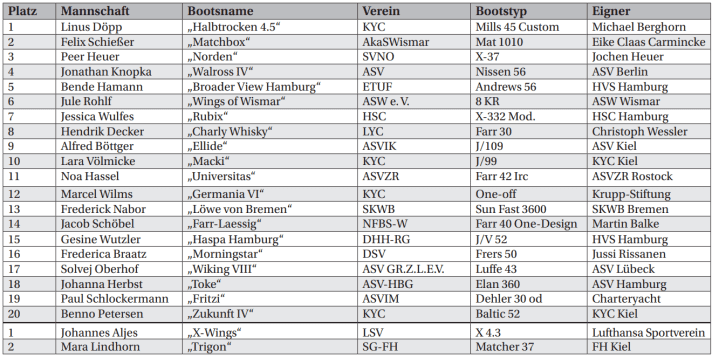
"A modest start ten years ago!"
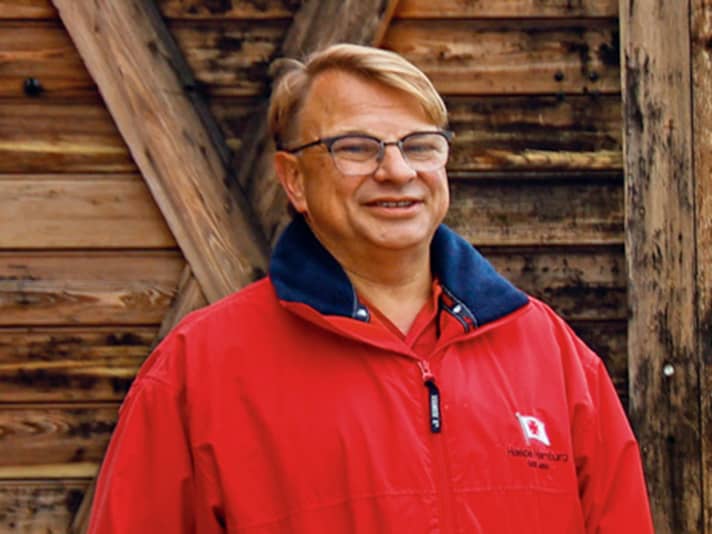
Joachim Brünner from the Hamburgischer Verein Seefahrt on the rapid development of the Commodore Cup junior regatta
What are the aims of the Commodore Cup?
Ten years ago, we started out full of ambition and modestly. The format has actually developed really well. Opening up to more boats is the right signal. The more boats, the better for young people, the more young people, the better for sailing.
Are there any ambitions to change the format or the route of the regatta?
The route has a long tradition. The approximately 80 nautical miles are a long, quite ambitious distance. Ideal for familiarising yourself with ocean sailing without being put off by demanding night sailing. Our challenge was and is to encourage young people to sail as skippers. We need those who are prepared to take on responsibility and pass on the tradition of ocean sailing to the next generation.
For the first time, the DSV took part with a youth crew. Will the association continue to support the event in other ways?
So that was really great. The DSV chartered a ship especially for us. That brought us a lot of additional attention, we didn't have that kind of reach before without the DSV. From Mona Küppers as President and Jonathan Koch as Vice President Youth in the DSV, we learnt about the great enthusiasm of the young sailors that this commitment of the association has triggered. If we could wish for anything, it would be that the DSV participates again next year with a crew.
Hamburgischer Verein Seefahrt manages three ocean-going yachts, the "Störtebeker", the "Haspa" and the "Broader View". How are they used in detail?
For all three ships, there is forward-looking voyage planning for the next season and the season after that. Every two years or so, we take part in international sailing events such as the Cape Town-Rio Race, Sydney Hobart and various transatlantic regattas.

